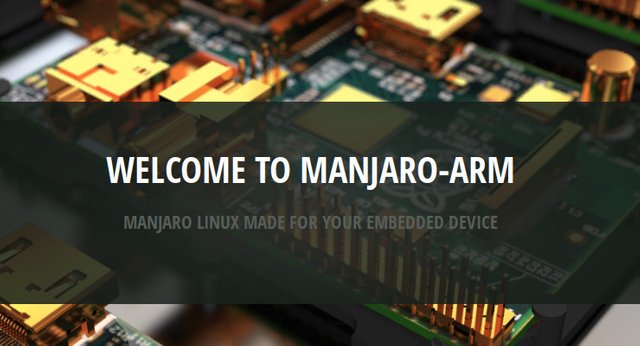Possible resurrection of Manjaro ARM!
Manjaro-ARM was a project that was created on January 2016 and shut down in early 2017, because not enough people where interested in keeping it going.

What Manjaro ARM is
Manjaro ARM aims to put the Manjaro experience onto embedded devices, just like Manjaro did for the desktop.
It was a 2-man project modt of the time, with just me and what would later become a very close friend.
When the project started the goal was to support the very popular Raspberry Pi 2 and the (at the time) brand new Raspberry Pi 3. We also wanted to support other devices, when more people joined the team. That just never happened. When the project shut down, we did have images for Raspberry Pi 1 Model B, Raspberry Pi 2, Raspberry Pi 3, Odroid-C1 and Odroid-C2. We also did some tests with Beaglebones and other devices, but never got an image for them.
Manjaro ARM never got the stamp of "official" Manjaro edition though.
Popularity of Manjaro ARM
Manjaro-ARM did manage to get some news coverage and podcast mentions here and there, mainly on the Ubuntu Podcast, Linux Unplugged (I think it was) and an article on SD Times.
We also heard back from lots of people when we decided to shut it down, that they use it a lot and are sad to see it go.
So we did have some kind of userbase.
Future of Manjaro ARM
I recently made a poll on the official Manjaro forum, to see if there was interest in bringing the project back to life. As you can see from the results, it's bit mixed, but there are a good number of people who where willing to help this time around, if it happened.
So I decided to see what it would take to bring the project back to life.
I did decide, that it would be done a little different than last time.
My initial proposal:
- No build server. Maintainers should build there own packages.
- Only a server edition, with no Deskto Environment
- Only 2 architectures supported from the start.
This quickly got some ideas and comments flowing and I have since changed my goal of the project, since some people volunteered to help out.
So as it stands right now, we are trying to do the following:
- 1 Build server, with 2 slaves to build packages for armv7h and aarch64 architectures.
- Image maintainers decide what images they want to support.
- Still only 2 architectures, as we want to support at least the Raspberry Pi 2 and 3 from the start, and maybe Odroid-C2 if I have time.
This will be about the same setup as we had last time. Where most of it was automatic, except package maintaining and image maintaining.
What we are working towards though, is a little up in the air. Some decisions have to be made. But we are working on another way of doing package and image building.
Dodgejcr (my friend) is creating scripts, that will build packages and images directly on the build server, instead of the slaves. This results in faster builds in general, since it will then be run on a x86_64 machine. So we could potentially envoke the scripts with the build server, so when a PKGBUILD gets updated in the github, it builds the package on the build server and places the finished package in the repository.
Speaking of repository, there is a few things we still need to decide.
Right now, the repository gets "copied" from Arch Linux ARM, and we merge our own packages into it, before uploading it all to our mirrors. So our mirrors are around 50 GB.
An alternative way would be to use the Arch Linux ARM mirrors directly and just add ours as a repository to be used before the Arch Linux ones. This would reduce our mirror size dramaticly, and Arch Linux ARM would get to "keep" their packages. It has a chance to mess up, if our mirrors are offline for some reason, because then it would install the Arch Linux ARM version of the packages instead. I am testing out this theory for the time being.
A decision also needs to be made about the build procedure described above. Do we build directly on the devices, like we do now. Or do we use the new scripts Dodgejcr is making?
I for one, am gonna vote for the one with least maintainance, which would be the new scripts AND the "lightweight" mirrors.
When all this is decided, we are gonna put it into motion and start updating our packages and putting together a few images.
Dodgejcr and I will probably still run the majority of the operation, but we do have at least 3 others wanting to maintain packages and a couple interested in maintaining images.
Conclusion
Manjaro ARM is probably gonna be reborn. With Raspberry Pi 2 and 3 support from the start, maybe more devices will follow.
We are in the process of setting everything up. Website will follow when we are ready to share anything concrete.